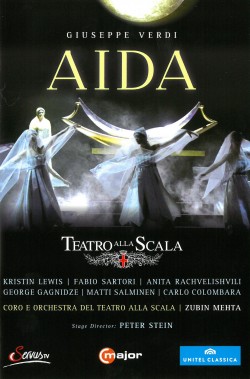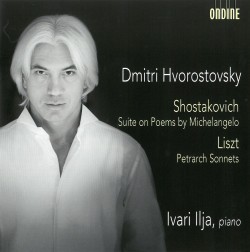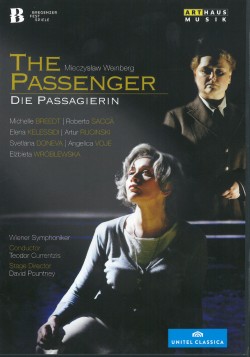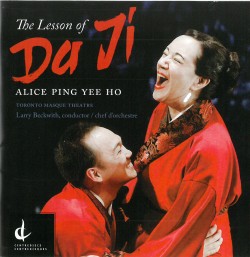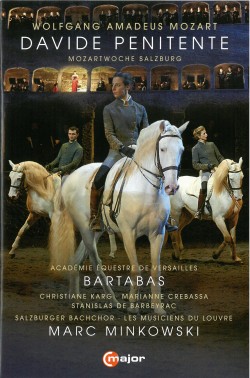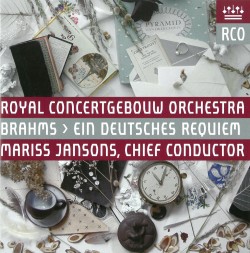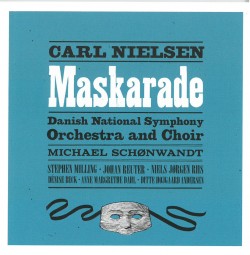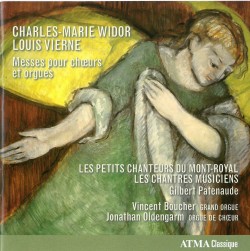Puccini: Turandot - Khudoley; Massi; Yu; Ryssov; Wiener Symphoniker; Paolo Carignani; Dessi; Malagnini; Canzian; Chikviladze; La Guardia; Teatro Carlo Felice; Donato Renzetti
Puccini – Turandot
Khudoley; Massi; Yu; Ryssov; Wiener Symphoniker; Paolo Carignani
C major 731408
Puccini – Turandot
Dessi; Malagnini; Canzian; Chikviladze; La Guardia; Teatro Carlo Felice; Donato Renzetti
Dynamic 33764
Puccini’s last, unfinished opera is arguably his greatest, certainly the most innovative, harmonically adventurous and a score of genius. It is also a grand opera well suited for lavish, extravagant productions. Fortunately, two marvellous video recordings have just arrived and both fulfill their promise. I state categorically that both are excellent in their own way and I do not prefer one to the other.
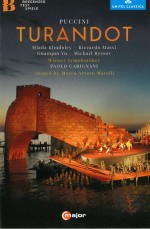 The newest is from the Bregenz Festival, July 2015 (bregenzerfestspiele.com). Not many may have heard of Bregenz, a sleepy old town at the Western end of Austria on the shores of Lake Constance (Bodensee), but their festival rivals Salzburg with the highest artistic standards. The giant open-air amphitheatre includes an incredible stage set (designed by M.A. Marelli) right in the lake with something like the Great Wall of China towering 100 feet forming the backdrop to a circular stage, a revolving cylinder accessed by ramps snaking around it like a Chinese dragon. Over this is a huge circular disc equipped with myriad LED crystals forming computer generated multi-coloured images to suit the mood of the moment. It really has to be seen to be believed and I must say it’s a lot more comfortable to see it on DVD in home comfort than being there freezing in the rain. (I’ve been in Vorarlberg and even in summer the weather is unpredictable.) The orchestra cannot be seen and nor can the conductor, the dynamic Paolo Carignani who gave Toronto a thrilling Tosca some time ago. The overall, somewhat modernized show is a sound and light extravaganza with dancers, pantomimes and circus acts to dazzle the eye, but the opera comes through musically superb with spacious acoustics and some top singing artists plus two choruses, not to mention the Wiener Symphoniker giving it orchestral support. Young Italian tenor Riccardo Massi (Prince Kalaf) copes well with the power and the high notes; he is best in show. Young, up-and-coming Chinese soprano Guanqun Yu gives a heartrending performance as Liu, the little servant girl who sacrifices herself for love. For the pinnacle role of the Ice Princess expectations are high and Callas or Sutherland both being gone, Mlada Khudoley, Russian dramatic soprano from the Mariinsky struggles heroically, suitably hateful most of the time, but relaxes beautifully to a glorious finale, an outburst of joy seldom witnessed in opera theatres.
The newest is from the Bregenz Festival, July 2015 (bregenzerfestspiele.com). Not many may have heard of Bregenz, a sleepy old town at the Western end of Austria on the shores of Lake Constance (Bodensee), but their festival rivals Salzburg with the highest artistic standards. The giant open-air amphitheatre includes an incredible stage set (designed by M.A. Marelli) right in the lake with something like the Great Wall of China towering 100 feet forming the backdrop to a circular stage, a revolving cylinder accessed by ramps snaking around it like a Chinese dragon. Over this is a huge circular disc equipped with myriad LED crystals forming computer generated multi-coloured images to suit the mood of the moment. It really has to be seen to be believed and I must say it’s a lot more comfortable to see it on DVD in home comfort than being there freezing in the rain. (I’ve been in Vorarlberg and even in summer the weather is unpredictable.) The orchestra cannot be seen and nor can the conductor, the dynamic Paolo Carignani who gave Toronto a thrilling Tosca some time ago. The overall, somewhat modernized show is a sound and light extravaganza with dancers, pantomimes and circus acts to dazzle the eye, but the opera comes through musically superb with spacious acoustics and some top singing artists plus two choruses, not to mention the Wiener Symphoniker giving it orchestral support. Young Italian tenor Riccardo Massi (Prince Kalaf) copes well with the power and the high notes; he is best in show. Young, up-and-coming Chinese soprano Guanqun Yu gives a heartrending performance as Liu, the little servant girl who sacrifices herself for love. For the pinnacle role of the Ice Princess expectations are high and Callas or Sutherland both being gone, Mlada Khudoley, Russian dramatic soprano from the Mariinsky struggles heroically, suitably hateful most of the time, but relaxes beautifully to a glorious finale, an outburst of joy seldom witnessed in opera theatres.
Review
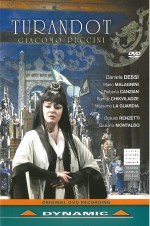 We now enter Puccini territory, because the next production is from Genoa, the heart of Liguria, the region where Puccini and most of the cast comes from. The Opera House in Genoa is a grandiose affair and the stage is very large and very high in order to accommodate the monumental set, a multi-level Chinese palace with staircases on either side. Ingeniously the set can easily adapt, alternately being grandiose or intimate, using lighting effects giving it different moods and gorgeous colours. Yet it remains entirely traditional, just as Puccini envisaged it. Being an Italian production, it is done with the emphasis on the music and the quality of the singers, which is superb. The leading lady Daniela Dessi, one of the top sopranos in Italy today, is a sensitive, even anguished and entirely believable Turandot. The primo tenore Mario Malagnini, a compassionate and tender Kalaf with tremendous vocal power even in the high tessitura, makes a strong impression. The young Roberta Canzian steals some of Signora Dessi’s glory with her brave and impassioned, beautiful performance as Liu. Right down to the lowliest choristers the singing is first class, but the three Chinese ministers deserve a special mention for their amusing, colourful and superbly choreographed trios that comment on the action with a rather cruel, even sadistic humour. And the one who controls it all is Donato Renzetti, an old hand in Italian opera who, with oriental rhythms and shimmering textures, makes everything come alive and throb with excitement.
We now enter Puccini territory, because the next production is from Genoa, the heart of Liguria, the region where Puccini and most of the cast comes from. The Opera House in Genoa is a grandiose affair and the stage is very large and very high in order to accommodate the monumental set, a multi-level Chinese palace with staircases on either side. Ingeniously the set can easily adapt, alternately being grandiose or intimate, using lighting effects giving it different moods and gorgeous colours. Yet it remains entirely traditional, just as Puccini envisaged it. Being an Italian production, it is done with the emphasis on the music and the quality of the singers, which is superb. The leading lady Daniela Dessi, one of the top sopranos in Italy today, is a sensitive, even anguished and entirely believable Turandot. The primo tenore Mario Malagnini, a compassionate and tender Kalaf with tremendous vocal power even in the high tessitura, makes a strong impression. The young Roberta Canzian steals some of Signora Dessi’s glory with her brave and impassioned, beautiful performance as Liu. Right down to the lowliest choristers the singing is first class, but the three Chinese ministers deserve a special mention for their amusing, colourful and superbly choreographed trios that comment on the action with a rather cruel, even sadistic humour. And the one who controls it all is Donato Renzetti, an old hand in Italian opera who, with oriental rhythms and shimmering textures, makes everything come alive and throb with excitement.


